Also - See photos and comments from other
CES & ICCE,
CinemaCon(Showest
),
CTIA,
SCTE |
|
|
Some years in the past the Consumer Electronics Association (CEA) has
seemed been a little too upbeat about the future of Consumer Electronics (understandably). This year they seem to be on more even keel. They estimate that 2013 ended essentially flat, after inflation, at $1 Trillion WW.
They estimage 2014 will be flat before inflation.
Underneath this topline number, two big shifts continue to churn the markets.
First, established markets (U.S., Europe, Japan) have
gone sideways while equal emerging markets ("BRIC", which includes China)
have caught up to be equal in size.
Second, tablets and smartphones continue to grow (now with 43% share) while almost all other categories are shrinking. That said, innovation in tablets and smartphones has been moving to the periphery (literally).
Hardware innovation within tablets and smartphones has
mostly been in cost/performance.
However, innovation is still easy to find at CES 2014.
You just have to look in the corners. |
|
CES Pre-Show & Press Events |
|
|
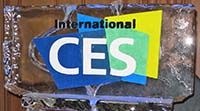
Welcome to DIGDIA's CES 2014
Photos & Comments!
|
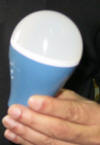 |
Speaking of innovation, cartoons
often show a bright idea with a light bulb. This LED bulb truly is a bright idea. When lit, if the power fails due to the utility or circuit breaker, this light bulb stays lit for 4 hours. If the bulb was off when power fails, it stays off.
Flipping the wall switch on or off produces the results you usually expect.
It has a processor in it. How does it work? Go figure. The bulb is called "Smart Charge" by iFi Systems. They will sell it for $25 after their successful Kickstart. |
QUIZ: The 2014 edition of CES is now
behind us.
We end this section with a question
-
What is Sealy doing at CES showing
matresses?
The photo shows only a
third of their huge booth.
We asked Sealy this
question and their answer may be a little disturbing to
consumer electronics fans.
See the answer that
Sealy gave -
click here |
 |
|
Are you a person that always forgets to bring your
iPhone charger with you on trips? if so, get the Pocket
Plug from Prong. It has a clever way of folding
the prongs away so the case is fairly flat. The iPhone 5
version is $70 and the iPhone 4 version is $60. |
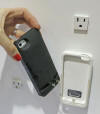 |
Helicopter drones are starting to find their way into several TV and movie
productions where ordinary booms are not practical. The one used on Gold
Rush had six rotars. This one from DJI Innovations has 8, so it can hold a
Canon D5. Available Q1. Price is not set.
But, to give you an idea, the
two smaller drones (Phantom 2) are around $1K |
 |
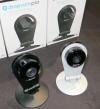 |
Dropcam has a pair of easy to set up Wi-Fi cams. You just need to provide
the Wi-Fi password. 720p Video is encrypted and streamed to the cloud -
then streamed to you. While the cams are $200 & $150 (depending upon
image quality), they also have a $10/month ($100/year) service that lets
you store 7 days of video and alerts you when something moved. Handy if
you use this to supplement an alarm. |
 |
There are lots of small Bluetooth speakers out there. The Lyric Duo from
Manhattan is unique because one speaker is for the left channel and the
other for the right channel - thus better stereo. Batteries play
for 20 hours. $139. |
|
Thermostats, even the smart ones, can usually only know the temperature
of the room they are in. This Eversense from Allure Energy uses small
sensors in each room to adjust the temperature for the room you are in.
The small Aura sensor is shown between the two phones. Tap the Aura
to tell the Eversense which room you are in. Also, the phone app
sends commands to the Eversense so that the HVAC turns on or off when you
are away or about to come home. $400 for the base unit. Aura
pricing is TBD. |

 |
Here is different way to adjust the room's environment. The
company's name is 'holi motion'. They sell an LED light that changes
color based on settings on your phone or iPad. You can set it to a
color or have it change based on the music that is playing. This reminds
me of the back lighting that Philips used to have on their TVs. It is
sold in European Apple stores for $200, and will arrive in the U.S. in
March. |
 |
 |
Having to wear dentures is not a happy experience, so finding a way to
speed up the process by 2X can be very attractive. AcceleDent can
do this for you. The device is worn for 20 minutes each day.
It vibrates. The vibrations stimulate the mouth is a way that
speeds up bone adjustment. This is not a toy. It is FDA class 2
approved and must by prescribed by a orthodontist. It adds about 10 - 15%
to your bill. |
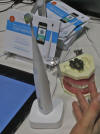 |
Once your teeth are adjusted, you can keep them clean with this
toothbrush from Kolibree. It tells you what your brushing technique
is and suggests ways to improve. You see charts on your phone or
browser. Under $200 when/if it comes out in Q3. |
|
Schwinn will be selling (starting March) the CycleNav. It uses an App on
your phone to plot a route. It also uses the phone's GPS. The CycleNav
then flashes direction lights and announces turns when appropriate.
It doesn't yet handle mountain bike trails (they are working on it).
$60 in March. |
 |
This is a Mother from "Sen.se" - SenseMother.com. Mother senses
what is happening from little wireless Cookies that you attach to things,
such as doors and various objects. You can then use a phone or web
to determine what might be going on. Mother can also say things
based on Cookie status, such as "Don't touch that". $223 buys a
Mother and 4 Cookies. Now, what would you do with this? Truly
reminds me of an old phrase - "there is a pony in there" |
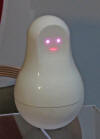
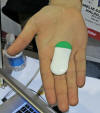 |
 |
Yes, you can now buy your own Star Trek pinball game from Stern.
The super pro version is $8,500 and it comes with all the bells and
whistles, literally. Other versions exist, including the "consumer"
version for $2,500. It has similar play but fewer bells and
whistles. |
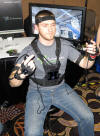 |
Not into pinball and prefer the shoot 'em up video games? Now you
can really get into it by wearing the Prio VR by YEI Technologies.
Sensors and switches that you wear substitute for all those tricky hotkey
sequences. Want to aim your gun? Just point and shoot.
$400. |
|
Many women are concerned about UV exposure because it causes wrinkles.
So, Netatmo in France has a UV sensor that you can wear on your wrist or
as a broche. It sends data to your phone so that you can put more lotion
on or make adjustments to what you wear. Available Q2 for $100. |
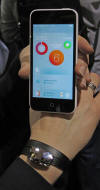 |
But, maybe you are concerned about exposure to that other form of
radiation - that stuff radiated by your phone! Dexim Santon wants
to sell you the XPower Skin for $69. It sports SAR Technology! |
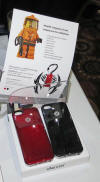 |

 |
There are some unique keyboards out there, but this wins the prize.
You can place a tablet on it and then type with your fingers. The
top photo is how it looks (without tablet) while you type. The keys
are underneath (bottom photo), so letters light up to give you visual
feedback. They claim that after several hours you can type as fast
as on a standard keyboard. They hope to sell it to healthcare
providers. The company is TREWGrip, and the $250 keyboard may come out
Q4. |
 |
There are going to be a lot of watches this year. This is a product
category that has yet to find total acceptance in the market. Just
to pick on one company, amongst many, here we show the Sapphire Wellness
Watch from Wellograph. It shows graphic health info and tells time.
Q2, $320. |
Day Two of the press and media events always starts with LG at 8am.
While most of the focus has turned to other product categories, TVs are
still on display. LG is involved in Plasma, LCD/LED and OLED. The one
immediately to the right is a 105" curved LCD with an aspect ration aimed
at widescreen (2.39:1) movies. This display is 21:9 (2.33:1), "4K" and
curved. It replaces the need for a front projector in home
theaters, if you can afford it.
The TV to the far right is a 77"
curved OLED TV. No price at this time. |
 |
 |
 |
Curve is in at LG. Their curved phone is available elsewhere and
will soon be available in the U.S. Why a curved phone? 90%
cute, 10% benefit. The curve conforms slightly better to the face,
much like how old style home phones do. The rest of the "benefits"
are a stretch. For exampe, "now you can view movies on your phone
in a more immersive way." Meantime, if you place it on a table, it
will be easy to accidently spin it round and round, creating a scratched
up spot on the back of your phone. |
 |
More phone tricks. Continuing the trend of using the phone as the
UI for all kinds of things, LG will now allow you to "chat" ("text") with
your home appliances, such as the washer and fridge. They call it
Home Chat. Now instead of talking to Siri, you can ask your washer "what
are you doing?" This can be a wonderful conversation piece at
parties. Again, 90% cute, 10% benefit. |
|
A more interesting development is that Netflix will soon stream 4K
content to LG (and other's) devices. And, not just some demo stuff,
but programming like Emmy winning House of Cards. This show was produced
by Netflix in 4K. |
 |
Panasonic has been slowly moving away from many CE categories and
emphasizing industrial markets. They are a major supplier of
batteries to Tesla, the leading AV supplier for airlines, and involved in
automotive electronics, including Internet radio (Aupeo), heads up
displays. Shown on the right is a 4K cam aimed at movies and TV
production. This can record 4K at 120 fps. More on this after NAB.
More on Panasonic later this week |
 |
 |
Samsung is among the harder to get in press meetings, with the payoff
being a surprise or two. This year it was a TV that goes from flat
to curved at the push of a button. So, why? Maybe because you
are single and when your date comes over you flip the screen to curved so
that you both have to sit close together in the sweet spot. |
 |
Seems, like last year, everyone is buying (or stealing) each other's big
displays. As such, Samsung also showed off their "World's 1st" 105
inch curved 21:9 TV. Sitting in the press room one could hear
comments like "nice buy who would buy it?" The answer is the folks
that currently spend north of $250K on home theaters, where front
projectors are currently the only solution. Not yet here in this
form, but add Dolby 3D and sound and you've got a killer home theater. |
|
Samsung is introducing UHD/4K TVs in sizes 50 to 110 inches.So, will
there be anything to watch? Here is a line up of content partners
that will soon be delivering things to watch in 4K. |
 |
Some games don't need the power of an XBox or PlayStation. Samsung
is continuing to tap into the world of games developed for the phone and
making them apps for their TV. |
 |
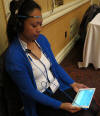
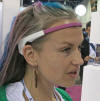 |
Need help to relax? Interaxon has the Muse bio feedback system.
The girl is wearing a prototype version (the production version is
slicker looking). It has two clips that attach to your ear lobes
and other EKG like sensors. The headset announces instructions
while it calibrates (takes a few minutes). The tablet give visual
feedback on your state, with cloudy skies indicating troubled mind and
chirping birds a peaceful mind. $300 in May. Go to
getyourmuse.com now and get it for $269. Update: the lower photo
shows the production version, which no longer needs ear lobe clips. |

 |
Dustcloud has a little Internet social game with a spy theme that goes
into the physical world. The tiny little "gun" beams an RF signal to the
target "gun" and "dusts" it (lights turn off and it vibrates). Web
site keeps track of the performace of all the "spies". This is a
Kickstarter company that has raised $12K so far. They intend to
sell the "gun" for $45 each. |
|
A company called "94Fifty.com" has a basketball with 9 sensors in it.
It can measure your ability to dribble and shoot. It gives you
visual and audable feedback. The lower picture shows feedback about
your shot. Available since last November for $300 |
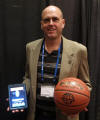
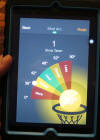 |
Recon Instruments has what one might call Google Glasses for the sports
person. The heads up display attaches to shades or goggles and
gives you info about thing and where you are. The wrist control
lets you call up commands and info, etc. The HUD goes for $350 |
 |
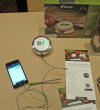 |
iDevices has some digital kitchen thermometers that talk to your phone.
Now you don't have to jump up all the time to see if the roast is done.
They don't have one for rotisaries yet. The larger unit with a
display (shown) is $79. A smaller simpler unit is $39. |
 |
SenSoria has some wearable sensors, such as the bra shown on the left,
that measure heartrate, etc. So, as you go running in the park you
don't have to worry about the sensor dropping off. Of course,
measurements go to you phone or tablet. Preorder for $59 now, but
$89 in a few weeks when it goes live. |
|
If you are willing to switch out your bike's handle bars, you can install
the Helios Biking system. The lights give you turn-by-turn
indications. But, the clever feature is the built-in GPS and GSM
radio. Now, if your bike is stolen you can track it down. The
unit shown will go for $279 when it comes out in March. |
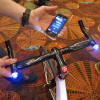 |
Here is another Kickstarter company called Pappy. Their device is a
passive set of mirrors that turns your iPhone into a 3D camera for both
capture and viewing. Youtube has long allowed 3D videos on their
site, and now you can post your own 3D after you buy their $59 Poppy. |
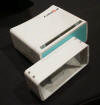 |
 |
Lumo BodyTech plans to sell these little sensors that you attach to your
shirt. The sensors then talk to your phone and tells you if your
posture is correct. If it is not, the sensor also gives a little
buzz. They plan to start sellng in this Summer for under $100 |

 |
A company called ION has some festive products for you party. The
larger Block Party (top) belts out your music and projects flashing
dancing colored lights that change with the beat. $249. The small
Rock Block LED does a similar thing, but at a much small scale. $69.
Looks like fun. |
|
So, maybe you've always wanted a Segway, but couldn't afford it.
Now Inmotion Technologies has the Sensor Controlled Vehicle (SCV) for
half the price ($2.5K). Performance about 75% of a Segway in speed
and distance. It operates in somewhat similar ways. |
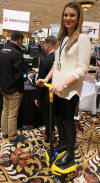 |
We will see lots of 3D printers this year, as we did last year and the
year before. Now is time to start asking what really practical
things one can do with them. American Pearl, a company that started
in 1950, wants to sell you jewelry that you customize on the web.
Your design in printed out and real gem stones are added. They claim the
gems are sold at a heavy discount and the resulting price is way below
equivalent products. |
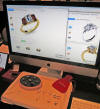 |
|
CES - Day 1 |
|
|
This the first official day of CES - always the busiest
day because most executives fly in for a day or two and then leave.
The Central Hall is where most of the big traditional CE names are.
This year, this means you had to have an Ultra/4K HD TV in your booth. |
 |
Sony kicked off the day with CEO Kasuo Hirai, who was born in Japan but
raised with heavy American experiences. Thus, his accent and stage approach
was totally American. He brought a new definition to Sony Style,
including a rather wholistic presentation. Here we see him (on the
right) talking Sony Pictures Entertainment CEO Lynton and Breaking Bad
creator Gilligan. The background slowly panned across art that was
manipulated by a crew of artists in the back room. Quite engaging. |
|
One of the more interesting Sony announcements was
PlayStation Now. This is a service that lets you
play PlayStation games on most any device. You
don't need a PlayStation because the game is rendered on
the server, then sent to your device (tablet, TV, etc).
They claim that the 720p image will be very low latency
(key in first person shooter games) as long as you have
at least a 5 Mbps Internet link. Games will be
available on a per-use or subscription basis. They
are testing it now and expect it out this summer. |
 |
The Sony DSC-QX10 and QX100 are Lens Style cameras. They work with
your phone via Wi-Fi (because Bluetooth can't yet handle video). The
phone replaces the display, controls and memory that are normally found on
the camera. The QX100 has a 1" sensor - not bad - so maybe it is not too
surprising that the list price is $499. The QX10 is $249. These
are probably more useful for special situations, and less attractive to the
general consumer.
|
 |
 |
Sony mentioned, but did not emphisize their TVs during the keynote.
Nonetheless, they had a number of UHD/4K models on the show floor,
including this 85" model. |
 |
Gotta hand it to Sony for sticking with the idea of wearable displays.
Taking advantage of sensors now common on phones, this 3rd generation head
display tracks head movement so that the scene moves as you move your head.
These displays are getting to the point that some practical applications
(e.g. drones) can work. Cost is about $1K |
|
As mentioned earlier, Panasonic is paying more attention
to industrial markets. Their Toughbook and
Toughpads are an example. Their new FZ-M1 has an Intel
Haswell i5 processor for some serious work. On top
of the 7" display is an optical scanner and mag card
reader. $2.1K |

 |
This shows that start of 4K gaming. But, the real news might be that
Panasonic may be jumping in with both feet into UHD/4K across their CE
product lines. This means a deemphasis of HDTV sets. If so, the
focus works well with the decision to drop plasma. |
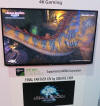 |
 |
Plasma's strength over LCD is in the darker tones and black level.
During Panasonic's press event they said that they have now developed LCD
technology that is as good as Plasma. Here is a poster that explains
some of what they mean. |
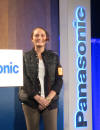 |
This person is wearing a camcorder. What makes it special is that it
records in UHD/4K. One more example of their switch to 4K.
Availability and price are not yet known. |
|
Residents of assisted living homes, many with dementia,
need help with reminders and staying in touch with
relatives & friends. Panasonic has been testing a
system called On4Today that helps these residents, their
family and the assisted living staff. While it
uses a connected display, the key is its cloud-based
service that makes it all possible. Expect to see
more later this year. Note: DIGDIA had a hand in
this. |
 |
Toshiba is the third one to show off a 105" curved UHD TV. Actually,
from a marketing point of view, they've properly called it a "5K" TV.
This suggests a way to resolve the conflict between "Ultra HD" and "4K"
labels. The "4K", or in this case "5K" indicates the horizontal pixel
count (rounded up), while the "Ultra" indicates something beyond HDTV. This
is similar to how "HDTV" needed the added lable of "720p", "1080p", etc.
Using this naming approach, the next logical thing is to apply it to an
"8K" display. See below... |
 |
 |
Toshiba also showed a concept that could be useful in certain settings,
mostly commercial. They place more than one display behind a large
black mirror and can show signage, programming, etc. It gives the
appearance of a very large display, but consists of lower cost displays. |
 |
So, here is an Ultra 8K display. Following the naming convention
mentioned just above, this display has nearly 8K pixels across. Sharp
has shown an 8K display before, but this year they've added the
Philips/Dolby autostereoscopic 3D layer to it. This 3D works farily
well on a 2K display, even better on a 4K display and very nicely on an 8K.
We've explaned this technology in earlier reports. |
|
It is not always obvious at CES that many products are
either pre-accounced or "concept" - meaning you can't
buy it. So, Sharp had to make sure you knew that you
could actually buy this 90" UHD 4K TV. |
 |
Of course, if you have room for a 90" TV, you probably have room for this
110" UHD 4K TV from Samsung. This one is also available, if you have
$150K |
 |
 |
Here is another of the rare situations when a curved display might make
sense. While its use for gaming is a bit of a luxury, stock brokers
are always using multiple monitors. Combine this with 4K and you can
show a lot of stock data. These monitors from Samsung are not yet
available. |
 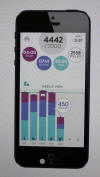 |
FitBark aims to help you make your dog healthier by monitoring the dog's
activities. The little dog bone shaped sensors go on the collar and
it talks to the dog house shaped base station via Bluetooth. Then, on
your phone you see if your dog has been sleeping all day. This is a
Kickstarter company. $149 buys the bundle. |
|
Immersive VR display games suffer from one thing - you
have to stay in one place and use buttons to move.
Virtuix has the Omni system that lets you move around by
walking, running or jumping around your battlefield.
You strap yourself in so you don't really move, but it
senses when you want to move within the game. It
doesn't yet let you crouch without a button push, but
they are working on it. June, for $500 |
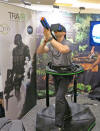 |
If you are a skateboarder Future Motion has a way for you to never have to
take your feet off the board. You ride and turn this "One Wheel" like
a skateboard, expept that the tilt determines speed. You can go about
5 miles on a charge and up to 12 miles (!) an hour. rideonewheel.com, it is
a Kickstarter company. September, $1.3K |

See Video
|
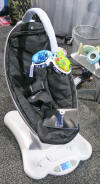 |
If you have an infant, you might have discovered that driving the baby
around in the car puts them to sleep. Maybe you did this in the
middle of the night? 4Moms has a solution - the MamaRoo has several
settings that let you rock your baby back to sleep. It costs $200 to
$250, depending upon fabric. |
 |
Once your baby is sleeping, do you use a baby monitor? Sensible Baby
(mysensiblebaby.com) has a way to monitor your baby via your phone.
Slip the sensor in the pocket of the "Onesie" jumper outfit and you can
tell if your baby is not happy or has turned over onto its stomach.
$149 buys the sensor and 3 Onesies. |
|
So, you just bought your Apple Air or Ultrabook.
"Just 3 pounds". But, now you also have to carry around
a huge AC adapter. FINsix is working on an AC adapter
that provides 65W of power from a very small package.
The photo shows an iPhone AC adapter next to the FINsix
adapter. Power supply designers will say "ah,
switching power supply". But, this one switches at 63
MHz (not KHz). They hope to sell it for $89 this
summer |
 |
Instabeat has a way for swimmers in training to see their heartrate while
they are swimming. Sensor info is displayed in their swimming
goggles. instabeat.me, April, $150 |
 |
 |
Serious gamers overclock their processors to gain that extra edge.
Overclocking makes the processor overheat, which causes failures. So,
gamers use liquid cooling. Water is the best heat conductor, unless
it leaks. Captherm Systems thinks they have the solution - the MP1120.
This does not use water, but a more volatile liquid that is vaporized by
the processor's heat. The condenser then returns it to a liquid. Sort
of like air conditioners. They say it is 10 degrees Celcius cooler
than water-based systems. |
 |
Panono has a ball that you toss into the air. When its sensors
determine the ball has reached the apex, all the cameras click. It takes a
picture that stitches together for a complete spherical image (360 x 360,
if you will). There are 36 cameras, that create a net 108 megapixel
sperical image as a result. The ball is supposed to withstand a 15
foot drop, so don't get too wild on the toss.
While the average
consumer may not wish to pay the $599 price (comes out in Q4), one can
imagine some commercial use.
|
|
Meet MiP (Mobile inverted Pendulum) from WooWee, a
company that has a nice track record for innovative
toys. MiP is like a little Segway toy. It even can
adust to carry small objects. So, now you can have MiP
serve cheese to your guests. MiP will be
exclusively at Best Buy (for 3 months) starting May for
$100 |
 |
Double Robots has a virtual you (your Double) on Segway-like wheels.
An iPad shows your face (or anything else from your phone or pad camera).
The iPad goes up and down on command. Batteries last 8 hours. They
just introduced a charging station that you can drive your Double into, so
you don't have to be near it to recharge. A downward pointed camera lets
you steer it into the station. Double sells for $2.5K. Who uses
this? They say telecommuters that don't want to be stuck in one place
during teleconferences.
|
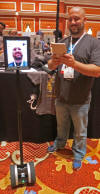 |
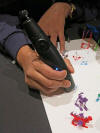 |
3Doodler Video |
A still photo doesn't do justice to some things - like this 3Doodler
(www.the3Doodler.com). While some companies sell 3D printers that
make you learn a complicated software program, 3Doodler lets you just draw
in 3D. One can make some very complicated 3D objects. The ones shown
here are just some of the simple "doodles". They sell it online now,
but it will be hitting the retail space in March. $99 buys you the
3Doodler and a starter supply of plastic. Click the video link to the
left to see it in action. |
|
CES - Day 2 |
Day Two of CES and we start with a few 2nd tier players,
notably from China. Seems they got the memo and
showed up with curved UHD 4K TVs, too.
A
conversation with a Silicon Valley integrator
(CyberManor) that installs home theaters uncoverd
another issue with curved TVs. He said "people
don't want to see the gap on the side of TV. He
agrees that in a dedicated home theater room, a 105"
curved 5K would be nice.
We can think of 4 curved
display markets. Dedicated home theater, digital
signage, stock brokers, and rich braggers (but, maybe we
just repeated ourselves). |
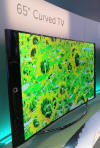 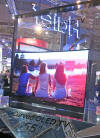
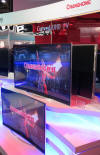 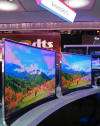 |
Qualcomm makes the Snapdragon 800 (and soon 805) processor, used in some
devices. Here they show how a company, like a Samsung (Note 3) or
Acer (Liquid) can capture and stream 4K video at full 30 fps.
Qualcomm and NVIDIA compete at the high end. Which trumps which -
communications or image processing tech? Meantime, Intel is trying to
wedge itself in, which mean the third variable is bank account, which will
be needed to disrupt the installed base of ARM fans.
|
 |
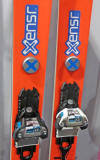 |
Xensr wants you to attach their sensor to your skiis, snowboard,
windsurfer, etc. Once you do, you can transmit or capture and store
telemetry information, including 9-axis orientation and GPS
Lat/Lon/Elevation. While GPS is captured at 5 Hz, they interpolate to
get and equivalent of 100 Hz. The result can then be plotted for
analysis. The GPS Xsenr is $200, and the non GPS version is $130.
If you put them on skiis, you need one of each. Intro in April. |
 |
Astro makes a Signal Generator that can be used to check out new designs,
such as the Panasonic Blu-ray UHD upscaler board seen in the front.
The Signal Generator exercises the circuitry so that the engineer can
measure results (in this case an eye diagram seen on an Agilent sampling
scope). The Astor Signal Generator costs $28,600. Shocked at
the price? There is not much volume in this market, but if you are in
the business, you gotta have one. |
|
If wasn't obvious in previous years, it was obvious this
year - innovation is happening around the sensors. One
example is eye tracking, which has existed for some
time, but is now taking baby steps into the consumer
space.Shown here is a developer's version (see the 3 red
dots) of an eye tracker from Tobii. They are
working on a consumer version with Steel Series (an
interesting choice) that comes out mid-2014. It can
track at a 30 H rate and has about a 1/2 inch radius
accuracy. No one really knows how this will pan
out in applications and gaming, so they are taking it
slow. |
 |
Here is another company with an eye tracker. This one aimed at
Android. They, too, are taking it slowly. And, like Tobii, they
currently sell an SDK so that developers can play around with it and get a
feel for just how to use this sensor.
Handicap aids are one obvious
and immediate application, so these are currently found more frequently in
this market. No doubt, clever people will come up with some useful
applications (and not just games) once the accessability of these is more
common - and maybe even built into mainstream phones and tablets? |
 |
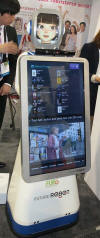 |
Future Robot has a couple of versions of this device, which they call
FURO-D. Imagine that you are a retail store and you want to get the
attention of your customers, and perhaps let them interact with your kiosk.
This autonomous robot will try to do so and engage the customer with a
talking figure. It can be programmed and controlled remotely via
Wi-Fi and once programmed, it runs on its own. This version costs
about $30K |
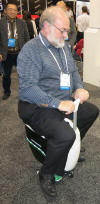 |
EasyVehicle has a variation of the Segway-like copycats. Their
Ehowheel has a top speed of 25 Kph and a range of 35 Km. It costs
about $2K. Here we see a show attendee try it out as the company rep
looks nervously on. You can't see it in the photo, but this guy's
wife is also looking on nervously. |
|
Last year we showed a robot that clung onto your windows
while it cleaned them, much like the robot vacuum
cleaners do. This year GrillBot
(grillbots.com) wants to clean your BBQ grill.
$119.95. What will they think of next? How
about washing and waxing your car? |
 |
Thanks to Mike Demler for this photo. iGrow aims to help your hair
grow by blasting your head with lasers. But, don't take our word for
this - go to www.igrowlaser.com and learn more. $700
|
 |
|
CES -
Day 3 |
 |
NVIDIA introduced the Tegra K1. Gamers will know
that Kepler was the top of the line GPU, but only found
in PC cards, etc. Tegra K1 puts 192 Kepler cores into a 5
Watt chip. So, it is practical for tablets and even
phones. The photo shows an App that generates an
extremely photo-realistic face real time. The
person is turning the head with his fingers and the
response was instant. |
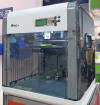 |
Lots of 3D printers here. This one from XYZ
Printing stands out because they intend to sell it for
$499, making about half the cost of the next lowest cost
3D printer. Last year the lowest cost printer was
around $1K. Projecting into the near future, and we
should not be surprised to find a $200 3D printer.
The real challenge will be what to print. Arts and
Crafts is natural market. One can see FIMO clay
being replaced by 3D printers. |
|
3D Systems is replacing those life-sized photos with a
hole cut out for you to place your face so your friends
think you are a rock star or something. Here you
sit in their 3DMe Photobooth. It takes your picture from
6 angles. You then choose your hair and costume.
Next thing you get is a small figure with your face on
it. You pay $65 - $75. The photobooth is
under $20K. |
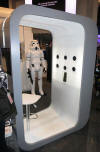 |
 |
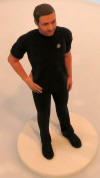 |
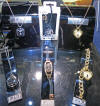 |
Most "wearable electronics" are not ready for primetime.
EZIO is an exception. Their jewelry is aimed at
women that would like a flashy, yet discrete indicator
that they just got a text or phone call. The
jewelry flashes a light behind one of the jewels.
It also tells you if you walked away from your phone by
accident (it can buzz). This is sold in Hong Kong today,
but it is coming to the U.S. soon for $129 |
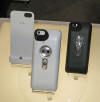
 |
FLIR has been selling "Forward Looking Infrared" products
for a few years. But, they were priced beyond most
consumers. Now they have the FLIR ONE, and it costs
only $349. It is designed to work with the iPhone 5 or
5S. They are working on Android. It has an
80x60 IR sensor, and a VGA normal sensor. The two images
are combined to give you an IR image with 1 degree F
accuracy and enough visual detail that inexperienced
users can figure out what they are looking at. Note the
stripes on the shirt - these stripes don't show if all
you had was the IR sensor. They are taking pre-orders
now, and general availability is in April |
|
A company called Carson has the MiniAura. This is
the smallest night vision scope on the consumer market.
It has a range of about 80 feet and sells for about
$130. This won't do the same thing as the FLIR
device wth picks up IR |
 |
LIT Motors has an interesting idea. This is an
electric motorcycle. It stays standing up by itself
by using a gyro. After you go about 20 MPH, the
wheels act as the gyro. The photo shows the vehicle
stopped and standing upright by itself. It stays
upright even in a crash. If you stop to park, a pair of
"landing feet" emerge. These feet also come out if
you lose power, so you come to a skidding stop. It
has a range of 200 miles and a top speed of 100 MPH.
They are taking pre-orders now for $24K. The intend
to ship at the end of the year. |
 |
 |
Monarch (monarch-power.com) has an interesting solar
panel. It fans out and can generate up to 1.2KW. It
is installed by the consumer, just plug it in. It
includes the inverter. If your home has a power
meter that is 15 years or older, chances you even get
credit from the power company for any excess power you
send them. It automatically tracks the sun. If the wind
or snow gets to extremes, the panel folds up like a
wilted flower. It even doubles as a patio umbrella.
And, it costs only $4K. |
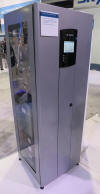 |
If you rely on solar or wind power, you know that they
aren't always available. Home energy storage
systems are getting more attention as a result.
Panasonic, Sony and others have shown such systems in the
past. Bosch is the latest to show a storage system.
This is their B{T-S 5. It comes in 4 to 13 KWH
capacities. It can source 5 KW. |
|
A company called Nio (www.bluenio.com) has been active
in the U.K. and is now bringing this product to the U.S.
The keyfob talks to the phone via Bluetooth. You
set the distance you want to let the keyfob be from the
phone before alarms set off. if someone steels
your phone, the phone locks and sounds out, and the
keyfob sounds off and vibrates. If someone steels
your keys, ditto (you specify this mode and the fob has
motion sensing). If you lost your keys, you use
the phone to have the keys tell you where they are.
Works with phones that support Bluetooth 4.0, They
will be building FitBit-like functions in the fob later.
Stolen phones are a big problem. Here is a $69
solution. |
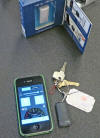 |
If you are into "Green", perhaps you've seen these at the
Apple store already. Evtec has their "Wood Series'
phone cases in various types of wood. You can't see
it, buy there is a Kevlar lining. The Wood Series
sells for $39. They also make a more expensive
carbon fiber series. |
 |
|
CES - Day 4 |
 |
While UHD 4K has the obvious increase in resolution, a more striking
difference is the ability to accept a wider and deeper color space.
However, content is still stuck in Rec 709 space and so the improvements
are lost. Technicolor is working on several things that aim to help content
cross over to UHD 4K world.
One program certifies HD to 4K
upscalers.
A second (see photo) takes Rec 709 color content and
expands the color to take advantage of the wider gamut of high end
displays. But, if you simply "stretch" the color to "fill" the wider gamut,
you end up with unnatural skin tones. So, Technicolor has an approach
that corrects this problem. The left display is a wide gamut display
and the upper left area is a "simple gamut stretch" image. The lower right
is the Technicolor version. The right monitor is a standard Rec 709
monitor. It may be hard to see the effects on the web.
The
third technology does similar things for HDR monitors. They can take
ordinary content and stretch it out such that the image can cross 20 F
Stops. Of course, you need a very special monitor and no consumer TV
can handle this, yet. The results are very dramatic and can't be
adequately illustrated via a photo here.
|
|
Continuing the theme of leveraging the display and
processor in your iPhone to do lots of things previous
done with dedicated equipment - we have the Iterium
Radiation Tester (top) and Food Tester (bottom). This is
a Russian company. The Radiation Tester goes for
$120. The Food Tester measures nitrates so you you
can tell if something is organic or not. It goes
for $90. These are out in March. |
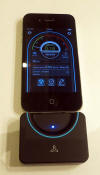 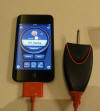 |
And, to carry your Radiation and Food testers, you need the TechSliner from
the company with the same name. Think of this as the hoster for
nerds. Or, on the practical side, some professions need to carry a
tablet but can't use their hands to do so all the time. The modle
shown in a 3 pocket version that goes for $65 - $70. A $45 single
pocket version also exists. |
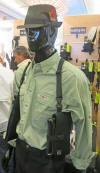 |
 |
This is a playground toy, meant to be installed outdoors. It is the
Neos 360. Neos has installed various models in a few hundred
playgrounds. This version has you race around pressing lit buttons
with the right color. Wack-a-Mole, but muct more exhausting.
The design to the baseball standard - that is, it needs to withstand a kid
hitting it with a bat. Costs about $30k installed. |
 |
Ever wonder what your dog or cat is doing when your are not looking?
Now you can find out by attaching a PawsCam to the collar. If it is
within WiFi range, you will be able to see things in real time.
Careful at parties! $150. The live feed version comes out in
March. Meantime you have to download the video |
|
Occassionally one finds a cute idea in the China, etc.,
booth area. Here we have CNDE Technology's Water
Show Speaker. $11, with minimum order of 500 |
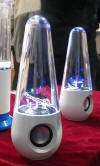
View Video
|
And, here an old trick - a small desk fan that displays a message, such
time of day or today's specials. Shenzhen Rioshengda Electronics.
$12, with minimum order of 1000. |
 |
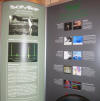  |
Most people are familiar with the term "mp3", and some with "m4p" and "16
bit PCM". These are all ways of digitizing audio. "mp3", in particular
gives audiophiles headaches because of its relatively compromised quality.
If you are such an audiophile, you might then know about "DSD", or Direct
Stream Digital, aka Super Audio CD (SACD), aka "1 bit", and its cousins
(top). Or, maybe you are in the DVD-Audio camp (bottom). Technically,
it is a bit like comparing digital FM with digital AM, though this
explanation will make engineers cringe. We are talking about the 0.1%
of the folks that truly feel they can tell the difference, even though by
the time they can afford this stuff their ears have gone to pot. All
of this goes under the umbrella of HD Audio, and the topic continues to
rage on in a small corner of CES. |
QUIZ: The 2014 edition of CES is now
behind us.
We end this section with a question
-
What is Sealy doing at CES showing
matresses?
The photo shows only a
third of their huge booth.
We asked Sealy this
question and their answer may be a little disturbing to
consumer electronics fans.
See the answer that
Sealy gave -
click here |
 |
|
ICCE (International Conference on Consumer
Electronics) |
If you are not familiar with ICCE, think of it as the
R&D counterpart to the Marketing done at CES.
Why
would you care? Because the R&D folks are inventing the
stuff that you will see in future CES events, only
they are talking about it now.
This year you may see
a visible increase in healthcare topics.
ICCE is run by the
IEEE Consumer Electronics Society |
Steve Diamond started his talk by suggesting that all of
the devices and systems today generate 1/2 Gigabyte of
data per person per day. A growing amount of this data
is generated by things, or as they say today the
"Internet of Things". This data is usually manipulatd on
servers, or as they say today, the "cloud".
But, it is not one big "cloud" - instead it is a
collection of proprietary systems that don't talk to
each other. If they did, the complexity of
maintaining translators between systems would quickly
become unmanageable.
So, the IEEE is working on
what they call the "Intercloud". This is an
upcoming proposed standard that offers a common
"language" or "protocol" for translating data on a
proprietary "cloud" to a common "intercloud". Now,
if two "cloud" systems wish to exchange data, they only
need one translator.
Why might we care?
Let's speculate. Another buzz word in industry is
"Big Data". Connect Big Data to the Intercloud (in
the future) and your car will be able to tell you to
turn right to avoid an ambulance that is going to an
accident that just happened a mile ahead, and taking the
left path would send you through heavier traffic.
Want to learn more? www.cloudcomputing.ieee.org
|
 
|

 |
Microsoft's
Kinect is being used for non-gaming applications. Researchers from
Taiwan have adopted it to Tai Chi, an Asian form of exersize where
movements are slow, but precise. Tai Chi can be used for physical
therapy, but the patient is not always able to travel to the doctor or Tai
Chi expert.
Using the Kinect, they digitized Tai Chi exercises
(standing and sitting). They then had people perform these exercises
by watching the monitor. The Kinect camera watched, and their system
then gave feedback on how to improve. |
Perhaps you wondered why LG showed how you can text
their appliances earlier this week. We did.
But, some researchers is Japan are taking a different
approach that could have some practical benefits for the
sight impaired. They have developed a relatively
cost effective way for the sight impaired to interact
with appliances with speech.
They used an
appliance that was available in Japan in 1993, the
"Morning Set", which cooks your eggs, toast and coffee.
The person uses a phone that has been available for the
sight impaired as the user interface. The phone
and appliance communicate via infrared, somewhat like a
TV remote, only enough information is communicated to
allow the phone to translate appliance settings into
speech. Tests with sight impaired people showed
that this system can work.
While this is a simple
unique example, it suggests ways that modern appliances
which have microprocessors can turn some of that power
towards helping sight impaired users. |

|
  |
An interesting thing about Digital Cinema is that the topic of Film Grain
continues to pop up Technicolor, a company that is deeply involved in
the industry, pressented a paper on managing film grain. There are a
few issues they are managing.
First, many movies are still produced
on film. Film grain adds visual noise, and noise does not compress
well. So, to save file and transmission costs, one might degrain the
image.
Second, some cinematographers prefer the look of film grain.
Certain period pieces are an obvious example. So, if the image does
not have film grain in it (either it was shot digitally or it was
degrained), it might be desired to add the grain back in. But, to
save storage and transmission costs, one can add the film grain look at the
reciever side.
Film grain is not just random noise. It was
certain characteristics, and it varies by color. Technicolor has
studied all this and has now developed tools for managing film grain. |
Here is another application for Kinect that the original
designers may not have anticipated. People that suffer
from long term chronic stroke impairment of movement can
make modest improvement in muscle control if they get
the right therapy. The simple form of therapy has
them do repeated movements, but there is little
connection to brain activity, so effectiveness is
limited.
Systems that try to measure brain
activity and associate them with muscle commands are
hampered by noise, such as other random movements.
Calibrating some of this noise out is difficult because
one needs to attach sensors to the person or try to
calibrate out delays in other feedback methods.
This Korean team uses a Kinect to instantly measure
movement and sensors worn on the head to measure brain
activity. They can more easily calibrate the noise out,
and feedback does not suffer from delays.
Exercises are thus more effective because relatively
useful and timely feedback is given to the patient. |
  |
  |
Devices for measuring all manner of health parameters (called Personal
Health Devices, PHD, in the top photo) were found all around CES this year
(more so than last year). More often than not, these communicated to
an iPhone or Internet using some kind of proprietary approach. Intel
initiated an alliance called Continua years ago to try to get some commong
communication architectures and protocols into the industry. These
researchers from Brazil are highlighting this effort in the top slide,
where the idea has been documented in IEEE 11073.
When something
communicates on the Internet, one of the most common general protocols is
TCP-IP. This protocol, however, has some overhead to add a little
robustness to the link. If, for example, a lost data packet is
detected, TCP-IP can request a resending of the packet. PHD's could
do without all this overhead.
CoAP is a simpler protocol intended
for simple low power devices that cuts out much of the overhead in TCP-IP.
These researches from Brazil have experienced about a 100% increase in
bandwidth efficiency. |
These Canadian researchers did a study of 3D and HFR.
So far, the Hobbit is about the only 3D movie to come
out in High Frame Rate, and the 2nd Hobbit movie
actually contrained the number of HFR screens.
There is controversy within the industry as to the
merits of HFR from an artistic view. The
"film-like" camp prefers 24 fps, while the "reality"
camp wants 48 or 60 fps. The eye can't tell much
differenc above 60 fps.
This study used a pair of
cameras recording at 48 and 60 fps. They then
constructed 24, 30, 48 and 60 fps 3D video clips. A
blind viewing test asked people to judge the best
experience. The chart shows the results (lower is
better). If there is a flaw in this study, it is that
cameras use in cinema can set their "gate" to greater
than 180 degrees, and emulating 24 fps by taking half
the 48 fps frames limits the gate to under 180 degrees.
The difference is most visible in scenes with motion.
|
  |
 
 |
These researchers in Taiwan are using facial and image processing
technology for a novel purpose - fashion. They have developed an
automated way to evaluate face shapes for the fashion industry. For
the consumer, buying fashion on the Internet might be influenced by the
face shape of the model in the photo. |
|
Pelican Imaging has taken a completely different
approach to cameras that results in a long list of
fundamental improvements. The top photo shows a
protoype camera 4 x 4 array measuring about 1/2 x 1/2
inch, so it can fit in a phone. Unlike conventional
cameras with mosaic RGB filters layered on top of one
sensor, this camera dedicates each camera element to a
color, like R, G & B, and even near-IR. Each camera
element can be individually shuttered.
The results
are as follows:
* Focus is maintained over a wider
depth of field, and depth of field can be specified
after the image is captured.
* Resolution is improved by a factor of 2.4 over any
individual camera element
* HDR photos can be made without worry of moving
subjects in the frame
* Depth mapping is possible, with improvements over
Kinect because the latter relies of IR images, which has
issues.
* A mask of the subject in a photo is easily created,
so this subject can be manipulated separately from the
rest of the image. So, for example, a person's
image can easily be cut out and placed against another
background image.
* The near-IR elements can be used to reduce noise in
low light images.
* Distortions in facial images that result from
having the camera too close to the subject ("selfies")
can be automatically corrected.
* Subjects in video conferences can be adjusted to
make it appear that they are looking at you, not the
screen.
The list goes on. This camera is not yet in
production, but technology is getting to the point that
it will soon be practical to have it in your camera or
tablet.
|
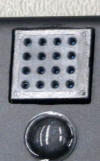  |
Did you see the
QUIZ? Click here
|

